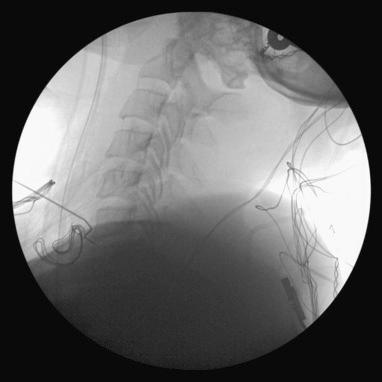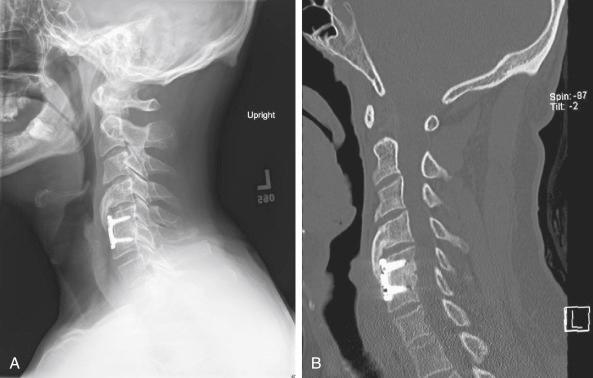Physical Address
304 North Cardinal St.
Dorchester Center, MA 02124
|
|
|
|
|
|
|
|
Adjacent level or adjacent segment disease was defined by Hilibrand and colleagues as the development of new radiculopathy or myelopathy referable to a motion segment adjacent to the site of a previous anterior arthrodesis of the cervical spine ( Table 55-1 ). Adjacent level degeneration , conversely, refers only to radiographic evidence of degenerative changes, whereas adjacent level ossification disease (ALOD) refers to anterior ossification at an adjacent level with or without degenerative changes within the disk space.
| Grade | Radiographic Findings | MRI Findings |
|---|---|---|
| I | Normal | Normal |
| II | Narrowing of disk space without posterior osteophytes | Signal change in intervertebral disk |
| III | Narrowing of disk space with posterior osteophytes | Disk protrusion without cord or nerve root compression |
| IV | Narrowing of disk space with posterior osteophytes | Spinal cord compression |
Adjacent segment disease is a relatively common phenomenon following cervical spine surgery. In their landmark article, Hilibrand and associates showed a relatively constant incidence of 3% per year for the development of adjacent segment disease following anterior cervical diskectomy and fusion (ACDF). These investigators demonstrated that adjacent segment disease requiring treatment was associated with fusion adjacent to C5 to C6 or C6 to C7 and in patients with preexisting radiographic degeneration at the adjacent level. The incidence found by Hilibrand and co-workers has been corroborated by other investigators.
Despite general agreement among investigators regarding the risk of adjacent segment disease, consensus on its cause is lacking. Many investigators believe that adjacent segment disease is the direct result of surgical intervention. Several biomechanical and clinical findings support the idea of iatrogenic adjacent segment disease. Other investigators, however, believe that adjacent segment disease follows the natural history of cervical spondylosis.
Natural history cohort studies suggest a correlation of ACDF with adjacent segment degeneration. Matsumoto and associates compared magnetic resonance imaging (MRI) findings in 64 patients who had undergone ACDF with MRI findings in 201 asymptomatic volunteers. At a mean follow-up of approximately 12 years, the ACDF-treated group had significantly greater adjacent level decrease in disk signal intensity, disk herniation, disk space narrowing, and foraminal stenosis.
Several biomechanical studies demonstrated increased disk pressure and hypermobility in disks adjacent to cervical fusion. Eck and associates performed C5-C6 ACDF on six cadaveric specimens and measured adjacent intradiskal pressure and segmental motion during range-of-motion testing. In flexion, intradiskal pressure increased by 73.2% at the cranial adjacent level and 45.3% at the caudal level. Segmental motion increased at the adjacent levels in both extension and flexion. These results support the idea that adjacent segment disease is caused by increased adjacent disk pressure and shear forces compared with the normal state.
In addition to these biomechanical findings, several technical surgical issues have been found to play a role in adjacent segment degeneration, but not necessarily disease. Faldini and colleagues retrospectively evaluated 107 patients after single-level ACDF. At a mean of 16 years of follow-up, the group who underwent fusion initially in segmental kyphosis (postoperative sagittal alignment <0°) had a radiographic adjacent segment degeneration rate of 60%. In contrast, the patients who underwent fusion in lordosis (postoperative sagittal alignment >0°) exhibited a rate of 27%. Katsuura and co-workers retrospectively evaluated 42 patients after ACDF at a mean of 9.8 years. These investigators found an adjacent segment radiographic degeneration rate of 77% in patients fused in kyphosis.
Another technical issue believed to be predictive of accelerated adjacent level degeneration is incorrect-level intraoperative needle localization ( Fig. 55-1 ). A retrospective analysis of 87 consecutive patients following 1- or 2-level ACDF showed a 3-fold increase in adjacent level radiographic degeneration in patients who had incorrect-level needle localization. Patients who were correctly marked intraoperatively at the time of index ACDF had an adjacent segment degeneration rate of 32% at 2-year follow-up versus 60% in those who were incorrectly marked.

Anterior cervical plate position may also be another technical issue related to adjacent segment abnormalities. Adjacent level ossification disease (ALOD) is defined as the development of anterior ossification at a level adjacent to a fusion and has been shown to be correlated with plate placement less than 5 mm from the adjacent disk space ( Fig. 55-2 ). Park and colleagues retrospectively evaluated 118 patients at a mean follow-up of 25.7 months. ALOD developed in 59% of the cephalad levels and 29% of the caudal levels. Placement of the plate more than 5 mm from the adjacent disk space reduced ALOD rates from 67% to 24% at the cephalad level and from 45% to 5% at the caudal level.

In contrast to the contention that adjacent segment disease is iatrogenically caused by fusion, several other lines of evidence support the notion that the disease is caused by the natural history of cervical spondylotic disease. Reitman and associates, as well as Kolstad and associates, performed motion analysis in patients before and after ACDF by using either dynamic fluoroscopy or flexion and extension radiographs. Despite previous cadaveric findings, neither group of investigators found a significant increase in adjacent level motion after ACDF, thus refuting the claim of iatrogenically increased shear at the adjacent level after fusion. Fuller and co-workers used stereophotogrammetry to show that, although the presence of a fusion results in increased motion in the remaining segments, the motion is spread evenly over the spine rather than concentrated at the adjacent level. This finding suggests that all levels, and not just the adjacent level, are at an increased risk for symptomatic spondylotic disease.
Several clinical studies also support the natural history hypothesis. The study by Hilibrand and associates does show an incidence of 3% per year for adjacent segment disease. However, these authors found that the highest rate of adjacent segment disease occurred at C5 to C6 or C6 to C7 and only rarely occurred at C2 to C3 or C7 to T1. These are the same levels most likely to degenerate and require an index surgical procedure. Another interesting finding was that the rate of adjacent segment disease was lower in patients undergoing multilevel fusion than in those with single-level index procedures. If the cause of adjacent segment disease is iatrogenically increased adjacent level pressure and shear, then multilevel fusions should accelerate adjacent segment disease because of the higher shear forces adjacent to a longer construct. Instead, longer fusions tend to decrease adjacent segment disease, probably by treating the levels most likely to undergo symptomatic degeneration in the first place.
Other clinical studies also refute the iatrogenic argument. In a retrospective study of 864 patients who had undergone posterior laminoforaminotomy, Henderson and co-workers evaluated the presence of adjacent segment disease at a mean of 2.8 years of follow-up. These investigators also found a rate of approximately 3% per year, even though posterior laminoforaminotomy is a motion-sparing procedure. Lunsford and colleagues compared patients who had undergone anterior cervical diskectomy versus those who had undergone ACDF. Regardless of fusion state, these investigators found an adjacent segment disease rate of 2.5% per year in their patients. Both these clinical studies refute the idea that adjacent segment disease is caused by fusion and resultant adjacent level increased stress.
Although fusion per se has not been shown to be associated with adjacent segment disease, proponents of cervical total disk replacement have argued that maintaining index level motion may decrease its risk. Unfortunately, the available evidence does not suggest that adjacent segment disease is decreased in total disk replacement versus ACDF, although middle- to long-term data are not currently available.
Given the amount of available evidence arguing for both the iatrogenic and natural history theories, it is not surprising that the cause of adjacent segment disease remains unclear. However, evidence is sufficient to establish risk factors for the development of significant adjacent level disease. These risk factors include an index procedure adjacent to C5 to C6 or C6 to C7 and the presence of neurologic compression or radiographic changes at the adjacent level at the time of the index surgical procedure. Technical issues such as incorrect needle localization and index level fusion in kyphotic alignment increase rates of adjacent level degeneration, but not necessarily clinically relevant disease.
Become a Clinical Tree membership for Full access and enjoy Unlimited articles
If you are a member. Log in here